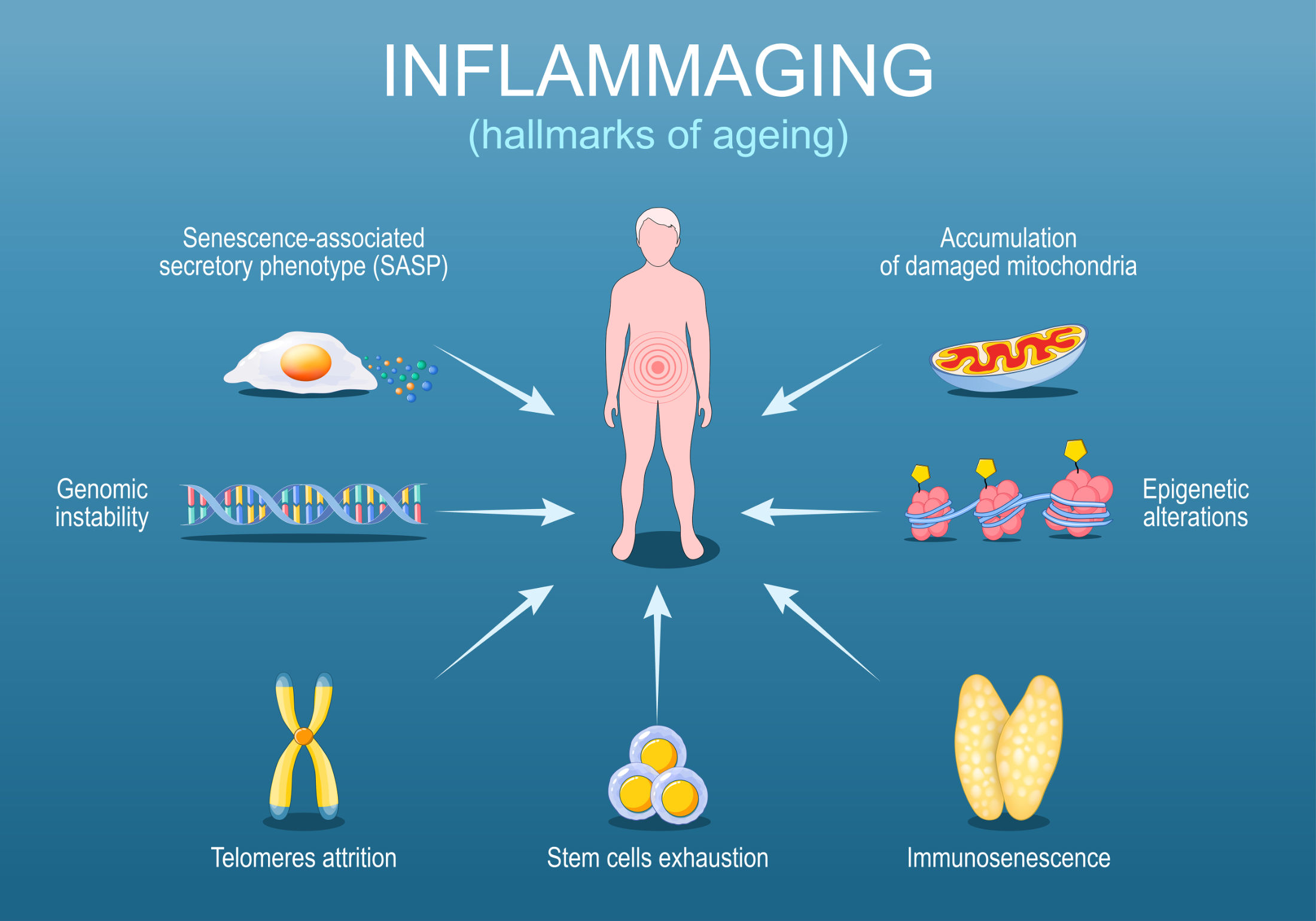
Inflammaging – there is a silent alarm system running in your body that gets louder with every year of life. Scientists have identified this insidious process as “inflammaging” – chronic, low-grade inflammation that slowly but steadily puts our cells into crisis mode. What was still considered a theory in 2000 was officially named as one of the twelve hallmarks of ageing in 2023 – and therefore the main driver of ageing. Read here how you can influence this process and turn back your biological clock!
The vicious circle of silent inflammation
Chronic inflammation is fundamentally different from acute inflammatory reactions. While the latter protect you from infections and allow wounds to heal, the chronic variant works in secret – subclinically, without obvious symptoms, but with devastating long-term consequences. The Italian gerontologist Claudio Franceschi coined the term “inflammaging” for this in 2000.
What begins as a natural ageing process develops into a self-reinforcing cycle. Ageing cells release inflammatory messenger substances, which in turn put other cells into senescence mode. This creates a domino effect that can have a massive impact on your health and quality of life.
The hidden trouble spots – what fuels inflammaging
But where does this silent inflammation come from? Several factors in your body and lifestyle act as real inflammation accelerators – often without you realizing it.
Visceral abdominal fat – the inflammation factory
Particularly tricky: visceral adipose tissue, which surrounds your internal organs, is much more than a passive energy store. It functions like a hormone-active gland that continuously produces inflammation-promoting messenger substances such as IL-6 and TNF-α. The more belly fat you carry, the more intensely your inner fire burns. Studies show: An abdominal circumference of over 102 cm in men and 88 cm in women already correlates with measurably increased inflammation levels.
Leaky gut – when the intestine becomes permeable
Your intestinal barrier plays a key role. Impaired intestinal flora (dysbiosis) and a permeable intestinal wall (“leaky gut”) allow bacterial components such as lipopolysaccharides (LPS) to enter your bloodstream. Your immune system reacts to this with a chronic state of alert – inflammaging takes its course.
Other inflammaging accelerators:

SASP – the dangerous cocktail of ageing cells
At the heart of the inflammaging process is the so-called “senescence-associated secretory phenotype” (SASP). This term describes a veritable toxic cocktail of inflammatory messengers, growth factors and proteases that senescent cells – cells in an ageing arrest – release into your body. These substances act like an accelerant: they promote chronic inflammation and can even force healthy neighboring cells into senescence.
Particularly problematic:
As you get older, your immune system loses the ability to effectively eliminate these problematic cells – creating a classic vicious circle.
The biomarkers of your inner fire
How do you recognize whether silent inflammations are wreaking havoc in your body? Scientists have identified several key markers that can serve as an early warning system. At the forefront are three inflammatory messengers: Interleukin-6 (IL-6), tumor necrosis factor-alpha (TNF-α) and C-reactive protein (CRP).
IL-6 in particular, also referred to by researchers as “the cytokine for gerontologists”, plays a central role. While IL-6 levels are normally low in young, healthy people, they increase with age. People with IL-6 levels above 2.08 pg/mL have more than twice the risk of dying compared to people with lower levels.
The situation is similar with CRP, whose values above 3.08 mg/L are associated with a 2.5-fold increased mortality risk. These markers are not just indicators, but active drivers of the ageing process.
Inflammaging as an accelerator of age-related diseases
Chronic inflammation is directly linked to almost all age-related diseases. From
- Cardiovascular problems over
- Neurodegeneration up to
- Cancer.
Inflammaging provides the breeding ground for these health risks. Epidemiological studies prove this: People with elevated inflammation levels are more likely to suffer from multimorbidity, mobility impairments and cognitive deficits.
The interaction between inflammation and organ systems is particularly worrying. In the bone marrow, liver and lungs, persistently high levels of inflammation can lead to irreversible damage. In addition, inflammatory messengers such as IL-6 and TNF-α weaken the anabolic signaling cascade, which contributes to the development of sarcopenia – age-related muscle atrophy.
The connection to other ageing processes
Chronic inflammation is not isolated, but networks with others Hallmarks of Aging. It increases DNA damage, impairs stem cell function and disrupts protein homeostasis. At the same time, it is itself fueled by these processes – creating a perfect storm of aging.
This might also interest you:
The Hallmarks of Aging:
How twelve biological switches point the way to longevity
Your inflammation control as the key to longevity
The control of chronic inflammation is becoming the linchpin of modern longevity strategies. Scientific understanding of the complex mechanisms of inflammaging is growing every day – and with it the arsenal of countermeasures.
By taking your body out of chronic inflammation mode, you can not only reduce your risk of age-related diseases, but also positively influence your quality and range of life. The fight against the inner fire begins with awareness of its existence – and continues with targeted measures for your long-term well-being.
Your anti-inflammaging strategy
Fortunately, you are not helplessly at the mercy of the inflammaging process. Scientists around the world are working on ground-breaking therapies, but you can already take simple but effective measures to counteract it.
The future: senolytics and senomorphs
In research laboratories, scientists are pursuing two fascinating approaches to combat the inner fire:
Senolytic strategies aim to specifically eliminate the problematic senescent cells – those “zombie cells” that secrete SASP cocktails. Agents such as dasatinib (a cancer drug) in combination with quercetin (a plant flavonoid) or fisetin (from strawberries and apples) have shown impressive results in initial studies. In mice, these substances not only extended lifespan, but also dramatically improved mobility and organ function.
Senomorphic approaches take a different approach: instead of killing the ageing cells, they silence them. These substances suppress the release of inflammatory SASP factors without destroying the cell itself. Rapamycin, originally an immunosuppressant, shows a promising effect here.
Most of these therapies are still in clinical trials – but the initial results in humans are encouraging.
What you can do today – your lifestyle as medicine
You don’t have to wait for the future. With the right lifestyle interventions, you can measurably reduce your inflammation levels – often within just a few weeks.

Diet: Eat inflammation-free
A healthy diet can prolong your life and acts as a natural anti-inflammatory. The key lies in the right composition:
- Polyphenols from colourful vegetables, berries, green tea and dark chocolate with at least 85 percent cocoa neutralize free radicals and inhibit inflammatory signalling pathways.
- Extra virgin olive oil contains oleocanthal – a substance with a similar effect to ibuprofen, only gentler and without side effects.
- Walnuts and other nuts provide alpha-linolenic acid (ALA), which your body converts into anti-inflammatory omega-3 fatty acids.
Particularly important for inflammation control are
- fermented foods such as sauerkraut, kimchi, kefir and natural yogurt. They strengthen your intestinal barrier and thus reduce the inflammation-promoting “leaky gut” problem.
At the same time, you should avoid refined carbohydrates and sugars that promote glycation and inflammation, as well as trans fats from industrially processed foods, excessive alcohol consumption and highly processed meat products.

Exercise: The anti-inflammaging miracle
Physical activity is probably the most effective natural senolytic available to you. Every training session triggers a process that goes far beyond muscle building. When your muscles contract, they release so-called myokines – messenger substances that have a direct anti-inflammatory effect. They reduce IL-6 and TNF-α, whereby paradoxically IL-6 is released for a short time during exercise, but has an anti-inflammatory effect there.
Regular training of at least 150 minutes of moderate activity per week can reduce CRP levels by up to 30 percent. The combination of endurance training, which improves mitochondrial function, and strength training, which prevents sarcopenia and activates autophagy in muscle cells, is particularly effective.
Even everyday movement counts: Every hour you spend sitting down measurably increases inflammation markers. Just two to three minutes of exercise per hour can neutralize this effect.
Sleep: The nocturnal repair workshop
While you sleep, your body’s own anti-inflammatory program runs at full speed. During the deep sleep phases, repair processes are activated, senescent cells are removed and inflammatory messengers are broken down. The research is clear: people who regularly sleep less than six hours have 40 percent higher CRP levels than late sleepers. Just one night of sleep deprivation measurably increases IL-6 and TNF-α. Seven to nine hours of high-quality sleep is optimal for inflammation control.

Stress management: breaking the cortisol vicious circle
Chronic stress is an inflammation accelerator of the first order. Permanently elevated cortisol levels weaken immune regulation and drive inflammatory processes. Meditation and mindfulness exercises have a proven effect here: just ten to twenty minutes a day reduces inflammation markers. MBSR (Mindfulness-Based Stress Reduction) significantly reduces IL-6 and CRP in studies.
Breathing techniques such as the 4-7-8 method or box breathing activate the parasympathetic nervous system – your body’s own calming system.
Also, do not underestimate the power of social connectionsPeople with stable social networks have measurably lower inflammation levels. Loneliness is as toxic as smoking. Time spent in nature lowers cortisol and inflammation markers – the so-called “forest effect” is scientifically well documented.

Intermittent fasting: the autophagy boost
Regular food breaks of 14 to 16 hours activate cellular autophagy – your body’s own recycling program. This breaks down senescent cell components and eliminates SASP-producing structures. Methods such as the 16:8 fast, in which you fast for 16 hours and eat within eight hours, show impressive effects: Reduction of IL-6 and TNF-α by 10 to 30 percent, improved insulin sensitivity, which reduces metabolic inflammation, and activation of sirtuins, the so-called longevity genes.
Food supplements: useful helpers
While a balanced diet forms the basis, certain supplements can provide targeted support. Omega-3 in the form of EPA and DHA can be supplemented with two to three grams a day if there is a proven deficiency. Vitamin D3 has an immunomodulating and anti-inflammatory effect at levels below 30 ng/ml. Curcumin, best combined with black pepper for better bioavailability, inhibits NF-κB, a central inflammatory switch in the body. Resveratrol activates sirtuins and inhibits SASP, while quercetin acts as a natural senolytic in doses of 100 to 500 milligrams daily. It is important to note that dietary supplements do not replace a healthy lifestyle, but only complement it.
Your personal anti-inflammaging roadmap
Controlling chronic inflammation is not a single intervention, but a combination of different factors. Start with small steps. Every positive change lowers your inflammation level – and therefore your biological clock. The research on senolytics and senomorphs is promising, but the most effective longevity medicine is already in your hands: your lifestyle.
Sources:
sciencedirect.com – Chronic inflammation and the hallmarks of aging
pubmed.ncbi.nlm.nih.gov – Chronic inflammation and the hallmarks of aging
nature.com – Inflammation and aging: signaling pathways and intervention therapies
pmc.ncbi.nlm.nih.gov – Inflammageing: chronic inflammation in ageing, cardiovascular disease, and frailty
brownhealth.org – Inflammaging: What You Should Know About Inflammation and Aging
🩺 Medically reviewed on 09.10.2025
This article has been professionally reviewed by Dr. Verena Immer. She is a doctor of integrative and anti-ageing medicine with a holistic approach that combines conventional medical knowledge with complementary methods. She has successfully applied the concept of individualized medicine in her own practice near Munich and currently offers personalized medicine – with a focus on longevity – in Switzerland.
Image source: istockphoto.com
- A plate that simulates a clock with the hands of a fork and a knife | Credits @ Rosendo Serrano Valera
- A senior man pensioner sits by the lake in nature | credits @ Halfpoint
- Young athlete takes a break after running | credits @ Zorica Nastasic
- Selection of healthy sources | credits @ JulijaDmitrijeva
- Your beautiful soul never goes out of fashion | credits @ Yuri_Arcurs
- TNT Dynamite | Credits @ JamesBrey
Disclaimer
This blog is for general informational purposes only and does not constitute the practice of medicine, nursing or other professional health care services, including the giving of medical advice, and no doctor-patient relationship is established. Use of any information contained in this blog or materials linked to this blog is at the user’s own risk. The content of this blog is not intended as a substitute for professional medical advice, diagnosis or treatment. Users should not ignore or delay medical advice for any medical conditions they may have and should seek the help of their healthcare professional for such conditions.










